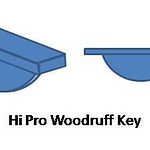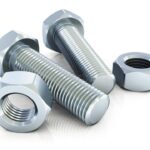Today we will learn about what is bearing and types of bearings. Bearing is a machine element that have constrained relative motion and use for reduces friction between moving parts of machine to obtain desired motion. We can say that the machine elements which support the rotating parts of a machine and reduce friction are called bearings. For example to stop deviation in a shaft of a machine while rotating, a bearing is used.
The word bearing is derived from the verb “to bear”. A bearing is a machine element that allows one part to bear another. The main functions of bearings are
- To reduce friction between moving rotatory parts.
- To support rotating parts of a machine.
- To bear radial and thrust load.
Types of bearings:
According to design, load and shape, there are many types of bearings use in industries. Generally bearings can be classified as follows.
According to the Friction:
on the basis of friction, bearings are classified as
1. Friction bearing:
As the name implies, in these bearings the bearing surface is in contact with moving surface or the shaft which produces more friction. These bearing are made up of cast iron, bronze, brass, Babbitt and white metal having hollow round shape. Lubricant is used for slow moving and heavy weighted running on shaft. These bearings are used to support crack shaft, rocker arm of IC engine. Friction bearings are also subdivided into following types
(A.)Solid bearings:
It is the simplest type in which a hole made in cast iron to support the shaft and to form running fit. These are made up of cast iron or bronze in the form of bush and press-fitted in fabricated or cast iron housings. This is used for small and light shafts moving at low speed. A hole is provided on its face of lubrication.

(B.)Split bearings:
Split bearings are same like solid bearings but have an arrangement of split. Split bearings are made in halves and assembled in special plumber blocks. It has collar on its external surfaces and also made in two parts as shown in figure.

(C.)Self-aligning bush bearings:
It consist mainly two parts. The first one is cast iron block and other is bush. These bearing bush are made up of brass or any other soft material in round shape. To protect it from moving, a screw is fixed at one end and this screw is fixed half to the bush and half in block.

(D.)Adjustable slide bearings:
It can adjust the tightness between bearings and the shaft. This type of bearing has provision for wear adjustment. The bearing is fitted in the tapered hole of the housing for adjustment of wear. The bearing is drawn inside by means of a slotted ring nut.

Advantages and disadvantages of friction bearings:
Advantages:
- Friction bearings are cheap to produce and have noiseless operation.
- They can be easily machined, occupy small radial space and have vibration damping properties.
- They can cope with tapped to the foreign matter.
Disadvantages:
- It damages machines.
- It restricts early movement of machine
- It produces a lot of heat energy.
2. Anti-friction bearing:
The main purpose of these bearings is to minimize the friction. Due to this reason, the speed of an object increases and friction and temperature decreases. Such bearings have long life. These bearings also sub-divided into following categories.
(A.)Ball bearings:
A ball bearing is a rolling element bearing that used ball to maintain the separation between the bearing races. The width of these bearing is smaller than the bore diameter or ball. On the basis of load and groove cut, ball bearings are classified in the following types.
(a.)Single row ball bearings:
These bearing have only one groove cut in outer and inner rings with the ball in identical line.

(b.)Double row ball bearing:
These bearing have two grooves cut in inner and outer ring lie in two rows of the bearing.

(c.)Self-aligning ball bearings:
These bearings can withstand with journal loads. These loads are generally inclined due to shaft misalignment. These types of bearings have a spherical bore on the outer race.

(d.)Angular contact ball bearings:
These bearings are designed to take an axial thrust as well as radial loads.

(e.)Thrust ball bearings:
These bearings are useful for taking vertical thrust load but cannot take any radial load. Some special thrust bearings are available which can also take horizontal end thrust.

(C.)Roller bearings:
Roller bearings are available with the grooved race in the outer and inner members. Roller bearings are capable of carrying the journal (radial) loads. It can work with greater load than ball bearings. To use this bearing, race is required to be locked. On the basis of uses, roller bearings are classified in following types.
(a.)Self-aligning roller bearings:
These bearings are self-adjustable and it is not affected by non-centering of shaft deformation flexure of shaft and bearing block, so it can compensate the concentric error caused by these reason.

(b.)Tapered roller bearings:
These bearings are used to take thrust only one direction. For opposing thrust, the bearings must be mounted in opposite pair. Tapered roller bearings are mainly used for high axial thrust loads.

(c.)Needle roller bearings:
These types of bearings have very small roller diameter. Rolling element is called needle roller. Needle roller bearings are used where the outside diameter of bearing restricted due to limited bearing space in the housing. The needles fitted in a circular cage which is push-fit in its housing.

(d.)Cylindrical roller bearings:
These bearings are used in such places, where more load is to be bear. These are made of hollow cylindrical roller.

(e.)Barrel roller bearings:
The roller fitted in this type of bearing has barrel shape. Its diameter up to full length is uneven. These bearings are self-alignment type bearing, so due to this reason, it has no difficulty to maintain shaft in straight line.

(f.)Spherical roller bearings:
These bearings are used in such places, where chance of angular condition in shaft may be possible. In these bearings, rollers are fitted in ball cage in such a way that in angular condition, in inner and outer race, the energy transfer can be possible in full capacity.

Advantages and disadvantages of anti-friction bearings:
Advantages:
- Special shielded bearing does not required lubrication again.
- It is easy to replace.
- It has very long life and has very less friction.
- It easy operates on high speed and required less lubrication.
Disadvantages:
- Initial cost is usually high.
- Greater diameter space required for comparable shaft diameter.
- Dirt, metal chips and so on, entering the bearings can limit their life causing early failure.
- Lesser capacity to withstand shock
According to the load:
On the basis of load applications bearings are classified as
1. Radial or journal bearings:
In this type of bearing, the loading is at right angles to the bearing axis, such that bearing is installed perpendicular to the axial line of the shaft.

2. Thrust bearings:
In these types of bearings, the loading is parallel to the bearings axis and collar is used to rotate the shaft at one position.

3. Pivot bearings:
These bearings are used for give support to the shaft in stationary position wherever bearings are in parallel to the axis of the shaft and one edge of the shaft is in the inside of the bearing. These bearings are also known as foot bearing.
4. Slipper bearings:
These bearings provides supports to the moving part or part in the straight line such as cross head which in used in steam engine.
According to the shape:
bearings are classified according to shape as
1. Flat shape bearings:
These types of bearings are flat in shapes which provide support to the sliding parts. Therefore, these bearings are also called slide bearing or guide bearing such as the movement of carriage on lathe bed.

2. Round or cylindrical bearings:
These bearings are in round shape which provides support to the moving parts as in case of solid bearing, ball bearing or roller bearing.

Today we have discussed about what is bearing and different types of bearings in detail. If you have any doubt about this article or if we have missed some other kind of bearings, let me know by commenting. If you have liked this article don’t forget to share it. Thanks for reading it.








I liked images
I need an address to bring a small starft to fit the berring to it. d.b.maskell@gmail.com. I live in Hillisborough d maskell
THANKS
thanks for provide so much best knowledge
Nice information about Bearings and it’s classification. I liked images.
Thank you sir
Veery good web site…I like this web